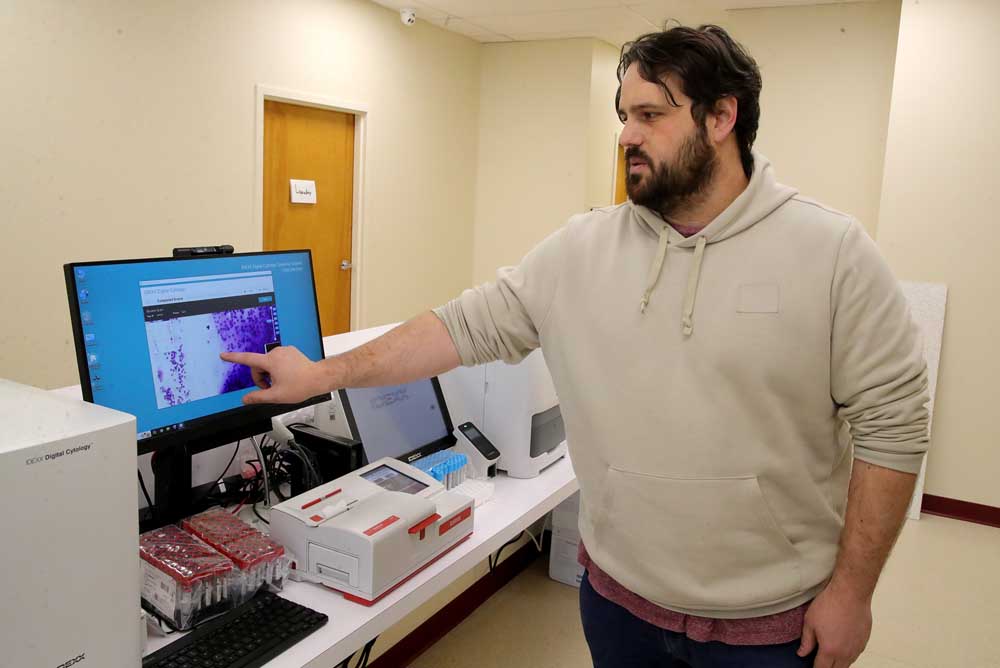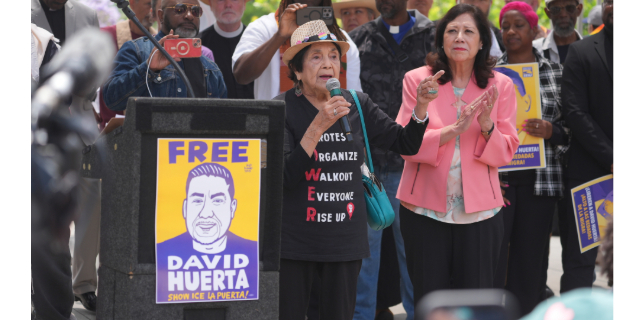New 24-hour veterinary ER hopes to help meet critical local need
Published 3:00 pm Wednesday, December 4, 2024

- Dr. Sam Lewis talks about the convenience of on-site blood scanning technology at the new Rogue Valley Veterinary Emergency.
A new emergency veterinary hospital opened Friday to offer increased access to affordable emergency care for pet owners in the region.
Dr. Sam Lewis, owner of Rogue Valley Veterinary Emergency, said he hopes to fill a desperate need for a level of care between regular veterinary clinics and the region’s emergency specialty veterinary hospital in Central Point.
Lewis, a Southern Oregon native, had been working since September to open his doors Friday inside Valley Immediate Care’s one-time South Medford location. The urgent care clinic operated inside the WinCo Shopping Center for about two decades. Following the Almeda Fire in September 2020, Phoenix Veterinary Hospital moved into the then-vacant space to operate its clinic while its Phoenix facility was rebuilt.
Lewis plans for his new hospital, which has been fully remodeled, to provide a full range of secondary emergency veterinary services with an emphasis on transparency and affordable, on-site options for diagnostics and treatment for lower-level emergencies. The privately-owned clinic will operate 24 hours per day, Friday through Monday. Lewis plans to eventually expand to operate seven days per week.
Lewis said he was spurred to open his facility because of a shortage of quality emergency care in the region and the fact that existing clinics suffer long wait times and even diversion to other facilities outside the region.
“We hope to help our local veterinarians by offering hospitalization referrals to enhance their care,” Lewis said.
“We hope to keep care more accessible by treating cases that won’t need specialty care to avoid specialty prices.”
Lewis said he designed and renovated the new hospital space under the philosophy of a “transparent model clinic.” An open-air floor plan allows pet owners to stay with their animal for the duration of treatment — except during surgery. Transparency, he noted, is a focus for both hospital design and philosophy of care.
“Every diagnostic should be shown to our client. I want our clients to be able to see everything and then be able to compare it to what’s normal,” Lewis said.
“Most clients that I’ve spoken to have never seen a cytology (screening) sample that they had in the hospital. … With our equipment here, I can literally show them what I’m looking at, as I’m looking at it.”
Diagnostic and exam areas of the clinic are in a large open area with smaller areas for specific needs such an intensive care area, isolation for pets with contagious conditions, radiology services and a special waiting area for enthusiastic barkers. Lewis incorporated features to provide results from diagnostic tests on-site and quickly. A blood gas analyzer will process blood samples in just minutes.
“If a patient has a clotting issue, or is septic or has rat bait toxicosis, I get answers right now so we can provide the needed care. And it’s a more affordable way to get answers about general things in blood,” he said.
“We read a sample and give you answers within 5 to 10 minutes here, which is incredibly fast. And not only that, it’s gonna cost our clients about $80 pop instead of needing to charge $300 and clients having to make hard decisions about the care they can afford.”
A hospital-wide medical gas system will provide critical oxygen support. Setting up plumbed oxygen was no small feat, Lewis said. The new system required skilled installation, costly materials and a fire-proof room for safe storage. Another type of storage, a high-tech “Cube X” digital medicine safe, will store and dispense controlled medications. That system will cost $1,050 each month, Lewis said.
“It requires two witnesses to be able to get a single medication out of it, which means that every drug is verified twice. Basically, any controlled drugs with capacity to cause harm will be safely stored,” he said.
“It’s extremely expensive to have, but I wanted it to make sure we maintain our patients’ safety. This is something that doesn’t produce any revenue for the practice. All it does is protect our patients, and that’s important to us.”
Lewis said he always anticipated returning to his native Southern Oregon to provide care for the region’s cats, dogs and other types of pets. After growing up in Southern Oregon, he attended Rogue Community College before heading to attend Oregon State University in Corvallis.
Despite a heavy IT background — evident in the modern tech used around the new hospital — Lewis said he always knew he’d pursue a veterinary career. A large amount of his ER vet training occurred in Los Angeles, where he worked as an emergency veterinary technician, and, after earning his degree, working as an emergency vet in the Dallas-Fort Worth area.
“I have come and gone from Oregon several times throughout my life. My family lives here. My brothers live here. I finally just figured, ‘If I’m gonna have this level of work, intensity and stress, I’m gonna be around my family,” Lewis said.
Lewis said he contemplated working for another facility or opening a new one to expand local offerings.
“I did a demographic study in this area and realized how much need there was. When you look at bigger areas, the ratios are much better,” he said. “Portland is a great example. You have a population of about 800,000 people and there are now 13 veterinary ERs covering that.
“Here, it’s been a population of about 200,000 to 240,000 … with one ER.”
Lewis said he’ll have a mix of doctors helping staff 24-hour shifts. Some will come from around the region while others have committed to fly in from out of state, Lewis noted.
“We’ll be flying them in and working them for the weekend.”
Lewis said care will be consistent, thorough and affordable at the new hospital.
“I don’t want people to see our facility and they say, ‘Oh, no, another corporate ER group is coming in. It’s just going to be more of the same.’ We really want people to have a different experience when they come here,” he said.
“I think that your local practitioners will tell you the same. They know that there’s more need for ER care, not just general practitioners. There’s more need for everything. … We want to be a good thing for the area.”
Moving closer to opening day, Lewis said he feels more resolved in his decision to expand the region’s pet health care offerings.
“When I had moved back and I was considering my options, I was trying to decide, ‘Is it now that I start my practice, or do I join another practice and work a little longer, trying to get more funds to get this thing going,’” Lewis said.
“I just decided, ‘No. Now is the time to do this. It’s never going to get any easier and there is a lot of need … Let’s just do it.’”






